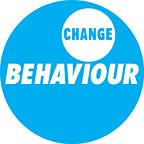The Tortured Norms Department
What do Taylor Swift and applied behavioural science people have in common? A go-to theme. For Taylor, it’s relationships gone wrong. For behavioural science practitioners, it’s social norms.
It is unarguable that Taylor’s songs about heartbreak have brought her huge fame and financial success. For those of us in applied behavioural science, well… we turn to social norms again and again, and for good reason: they’re powerful, have a robust evidence-base, and can be applied cost-effectively.
However, I would argue that norms aren’t always applied with the same level of nuance and precision that Taylor uses to cut down her exes. If they were, more interventions might come closer to meeting Swifty seismic levels of success. Let’s talk through a couple of real-life examples to explore why norms aren’t always used to their full potential. And — dare I say it — what we can learn from Taylor in order to stop torturing those poor norms.
Case number 1: Roadside littering.
This weekend, I noticed a sign by the motorway I hadn’t seen before. It read: 9 in 10 people don’t drop litter. The applied theory is obvious: this is a descriptive social norm, i.e. informing viewers what the majority do, in order to influence the minority who don’t.
Sadly, I think this is unlikely to change the behaviour of litterers in this context. Firstly, we know that people know that littering is wrong, and therefore it’s safe to assume that they would already know that most people don’t do it. What people do do is look for reasons to justify bad behaviour. One concern I have with this sign is that 10% is quite a significant minority. To put it into context, if this is accurate then there’s more than double the amount of litterers in the UK than there are redheads. The message might be read as, ‘actually, I’m not alone in doing this, therefore it can’t be that bad’.
So what’s the Taylor Swift lesson here? I’d say it’s about understanding the power of context. Taylor knows that her fans don’t take her songs at face value; that we enjoy them more because we know that it was Jake Gyllenhaal that kept her red scarf and that Matty Healy is the tattooed golden retriever. To change behaviour, we need to understand (and act) within the context where it happens. In our gum litter work, we learned that the behaviour is largely driven by situation, therefore the interventions we’ve designed prompt people at key moments before they might litter. We also learned that social judgement plays a role — so perhaps a prescriptive norm (which describes what is perceived to be the right behaviour) would be better placed to tackle roadside littering.
Case Number 2: Food Waste Collections
I have recently moved from London to a village in Oxfordshire. This means I’m getting used to a whole new way of life, learning how to do things like saying hello to people I pass on the street, and recycling my food waste.
I picked up a leaflet in my local library that was designed to help me with the latter. Its first line read: ‘More and more people are recycling their food waste in Oxfordshire’.
This is what we call a dynamic norm. These were identified in the literature a few years ago, with experiments showing that describing what people are increasingly doing can change behaviour. They’ve been shown to increase uptake of plant-based options and reusable cups, and reduce water use at home.
It’s all very exciting because it allows us to apply the power of social norms, without the behaviour actually being the norm.
However, this doesn’t mean that we could or should be slapping a dynamic norm on every intervention. Context matters here. The evidence so far for dynamic norms suggests that they help guide free choices. Kerbside recycling, however, isn’t about free choice. It’s about compliance. Introducing dynamic norms here plants the seed that you may choose to reject your food bin. Which is not a choice that we want people to be making.
So what would Taylor do instead? Well, in re-recording her albums, she set a new default and reframed her back catalogue. I bet if she were in charge of increasing uptake of food waste recycling, she’d look at the evidence to craft a course of action that meets the challenge at hand, in a way that resonates with people. Just as we would here at Behaviour Change.
As with all our blogs, the information contained in this post represents the views of the author and does not necessarily represent the views of Behaviour Change Ltd.
